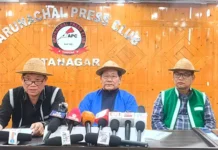Flights Of Fantasy
[ M Panging Pao ]
After the recent announcement by American defence HQ Pentagon, the media has been inundated with news that China has constructed a village with 100 plus houses 4.5 kms inside Indian territory in Arunachal Pradesh. However, according to local sources, satellite images indicate that the village is in Bisa area, near the Lensi river, in Limeking circle of Upper Subansiri district, also known as Tsari Chu in Tibet. This news has dominated the print, electronic and social media for the last few days. It appears that there is a bit of a false alarm and sensationalism associated with this news item. Readers may also recall the recent incident of four local youths of Arunachal being captured by the Chinese in the same area and later released near Kibithoo in Anjaw district of Arunachal. Initially reported as ‘being kidnapped’ by the Chinese, later it emerged as a case of getting lost during a hunting trip.
Analysis reveals that the line of actual control (LAC) has remained the same since the 1962 Sino-India war. The subject village was occupied by the People’s Liberation Army after overrunning an Assam Rifles post in 1959, in an operation known as the Longju incident. Since then, the reported village has existed at the same place under Chinese control. Recently, large-scale construction activity has been carried out in line with the recently declared Chinese policy of construction of well-off villages as border defence villages along the Indian border. This increased construction activity has been picked up and reported by the media as construction within Indian territory.
It is true that frequent border clashes have occurred after the Sino-India war of 1962, including at Nathu La in Sikkim in 1967, and the 73 days’ confrontation over Doklam in Sikkim in 2017. There have been Chinese incursions in Asaphila, Tuting and Chaklagam areas of Arunachal Pradesh in 2017-2018. Then there were the violent clashes in Galwan valley and Pangong Tso lake in Ladakh in 2020.
China has built robust infrastructure in the border areas with all-weather roads, railways, airports and modern villages. It may also be noted that infrastructure along the Indian side has also been expedited with many major projects being completed. The major projects include the road/rail bridge over the Brahmaputra at Bogibeel near Dibrugarh, the 9.15 km long Sadiya bridge, the 6.5 km long Bomjir bridge, the bridge over the Sisiri river near Dambuk, commissioning of six ALGs in Pasighat, Ziro, Mechukha, Aalo, Tuting and Walong, etc. Many other key roads, bridges and airports are under construction and are being expedited.
It is known that infrastructure is much better on the Chinese side, with India trying to catch up. The important lesson for the central and state government is to focus on improving the infrastructure along the border like all-weather roads, key bridges, railways, airports, etc. In addition, identified and selected villages along the border need to be strengthened and improved. This may be the only long-term way of countering the Chinese threat. (The contributor is retired Group Captain, Indian Air Force)



